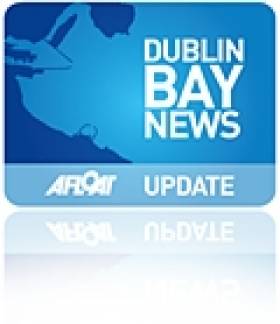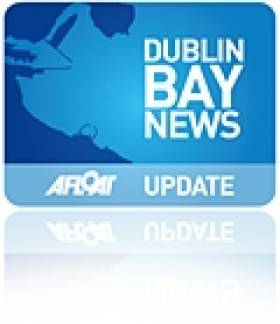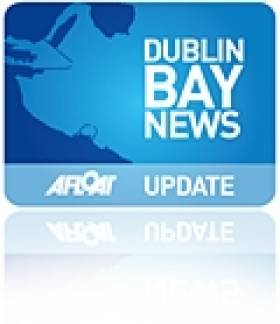Displaying items by tag: Coal Harbour Users Group
Coal Harbour Users Group (CHUG) Seek Public Marine Leisure Centre at Dun Laoghaire Harbour
#chug – The Coal Harbour Users Group (CHUG) is a group that represents the interests of leisure users of the Dun Laoghaire Harbour & Boatyard, and also the interests of the public that use the resource. Consistent with this, CHUG wish to promote marine related leisure and sport activity for the "ordinary person" in the Dun Laoghaire area and in Dublin Bay. During April 2015, CHUG made a submission to the Dun Laoghaire Cruise Stakeholder Group relating to the proposed new ships berth within the harbour. Part of the submission suggested development of a Marine Leisure Centre in the area west of the West Pier, and suggested that some of the spoil that would result from proposed harbour dredging be used to reclaim and extend land there to accommodate the development.
Kevin Woods writes that CHUG members have viewed the DLR Draft County Development Plan 2016-2022. In the context of the plan, CHUG make the following comments and requests:
CHUG request that the area immediately west of the West Pier including the area known as "The Gut" be designated for marine pleasure, leisure, sport and education use. The development would principally include:
A public marine leisure centre operated along the lines of a municipal leisure centre. This is detailed below.
A new public slip suitable for use by small boats at all tides. There are few public slipways in the Dublin area, and of those, some are not usable at low tide. An additional slip would improve public accessibility to the water and to Dublin Bay in general.
Additional space for marine leisure use, including for storage and repair of small boats and equipment. This might be provided by land reclamation in the area shaded and marked (1) on the attached map.
While the above development appears to be in line with existing Draft Development Plan SLO 14 and SLO 95, these might be reviewed and revised as appropriate should this be necessary to carry out the above. This might be assisted by introduction a new SLO relating to the area marked (1) west of the West Pier along the lines of the following:
Objective to promote water related leisure, sport, education, training facilities for public use at the coastal fringe in the area know as The Gut to the west of the West Pier that may include the reclamation of land and also the development of a new breakwater projecting westward from the pier side. This proposal would be subject to a feasibility study, including an assessment of any options, access considerations and impact on adjoining users. The feasibility study would include appropriate environmental assessments including any required under the Habitats Directive in co-operation with the relevant agencies.
A Marine Activity Centre might include:
Club facilities - offices, store rooms.
Shared meeting room, training / education room, changing room / showers / WCs.
Drying room for wetsuits,
Diving equipment store room
Compressor room for filling diving cylinders.
Small boat repair workshop
Shelters for persons, equipment
Hardstanding for secure dinghy & rib parking, canoe / kayak, windsurf and paddle board storage, small craft trailer storage.
Car, coach / minibus parking.
The centre might also cater for:
Fishing, birdwatching, and nature related activity, and might be a base from which the following would be organised:
Training in water safety
Transition year and primary schools activities
Beach and marine nature, ecology, and environmental study activity.
Marine related art
Youth club facilities
A new scout den
A marine interpretive centre / marine history and heritage centre
Dun Laoghaire Coal Harbour Users Group Suggest 'Marine Activity Centre' As Part of Cruise–Liner Development
#cruiselinerberth – Dun Laoghaire harbour as a leisure facility, is in danger of being damaged by the proposal of a cruise liner berth according to the Coal Harbour Users Group (CHUG) who have submitted a written response to Dun Laoghaire Harbour Company. The group says this is particularly so for dinghies and small craft, though this might be mitigated by development of alternative sailing area and facilities west of the harbour. The group have asked if it might be feasible for a lifting bridge be included on the access causeway to the new cruise berth and could a municipal marine facility be provided as part of the plan.
CHUG says the Impact on larger leisure craft appears to be less significant and it would be in favour of the cruise berth development if it is likely to financially viable and bring in revenue to the harbour company and / or local authority.
The CHUG response to DLHC is below:
Dear Sirs
Thank you for briefing the committee of Coal Harbour Users Group regarding the proposed cruise liner berth in Dun Laoghaire Harbour.
The proposed cruise berth is an enormous development that will project approx. 60% of the distance from the shore to the harbour entrance. The Harbour Company anticipate that the berth would be in use for approx. 100 visits per season – i.e. on at least every second day during the summer months. Other boat movements would be restricted while cruisers are moving / berthing in the harbour and manoeuvring outside the harbour. This berthing and manoeuvring is likely to be a slower and longer process than for the HSS.
The above is likely to represent an inconvenience for persons moored in the harbour or on the marina while entering and leaving the harbour, and while moving within the harbour. There may be occasions where a boat needs to urgently enter the harbour (e.g. emergency, weather conditions), and may be delayed by cruiser manoeuvring. Dinghy sailors are likely to be more severely impacted, particularly because sailing within the harbour will be restricted, and they may need to sail close to the harbour mouth while a strong south-westerly is blowing.
The disruption to small boat sailors might be mitigated by development of a Marine Leisure Centre and sailing area for dinghies and sailboards immediately west of the west pier. A marine activity centre might also provide activities and attractions for visitors on cruise liners. The idea of a marine activity centre is outlined later in this e-mail.
Items for consideration by the Stakeholder Group:
Might some of the gantries between the proposed cruise berth piles / fenders be lifted when not in use to allow dinghies to pass between them?
Might a lifting bridge be included on the access causeway to the new cruise berth?
Might land reclamation be carried out to facilitate the development of a marine activity centre? This might be achieved by use of spoil from dredging. The cost of pumping a proportion of this spoil across the west pier might represent a saving over the cost of its removal to the Burford Bank. The above would be subject to further investigation, EIA, and planning requirements. Based on anecdote, spoil dredged from the harbour may contain pollutants including toxic substances. The spoil from close to the harbour mouth and from outside the harbour may be less contaminated.
The suggested Marine Activity Centre would:
Be a municipal building operated on the lines of a local authority leisure centre, but incorporating facilities for clubs and organisations that would be available for a nominal cost.
Encourage, promote and enhance public access for the "ordinary man" (and youth) to the sea and to marine leisure and sporting activities. This would include persons that are not members of the yacht clubs and other existing (privileged) organisations around the harbour.
Provide a facility for delivering Water Safety Education (classroom / lecture room, practical work area)
Provide showers, changing rooms, offices for clubs and organisations, boat / windsurf / canoe storage yard.
Incorporate a new slipway for dinghies and shallow draft boats (there are very few public slipways in the Dublin area).
The sailing area would include a safety boom a few hundred metres offshore, and removal of rocks close to the shore (or marking of them).
Provision of a cantilevered pedestrian boardwalk along the harbour wall alongside the access road east of the DMYC, and widening of the access road. Development in the West Pier area has in the past been restricted by access road width. This may provide a solution to access issues.
Summary:
In our opinion, the harbour as a leisure facility, is in danger of being damaged by the proposal. This is particularly so for dinghies and small craft, though this might be mitigated by development of alternative sailing area and facilities west of the harbour. Impact on larger leisure craft appears to be less significant, and mainly represents an occasional inconvenience. In principle, CHUG would be in favour of the cruise berth development based on the information provided by the Stakeholder Group if it is likely to financially viable and bring in revenue to the harbour company and / or local authority.
Green Party Speaks Out for Small Boat Owners in Dun Laoghaire
Ciaran Cuffe TD of the Green Party has spoken out in support of small boat owners in a submission to the Dún Laoghaire Harbour Masterplan. Cuffe, a candidate in the General Election, says the prioritisation of space within the harbour for surface car parking and marshalling yards for ferry services has reduced the space available for small boat owners. Cuffe says the masterplan should specifically enhance facilities and storage space for small boat owners, such as the Coal Harbour Users Group (CHUG) and local yacht and water sports clubs. He also says consideration should be given to the development of workshops to promote traditional boat building and small craftrepair and restoration.
The full submission from Ciaran Cuffe is below:
"I welcome the preparation by the Dún Laoghaire Harbour of a masterplan for the harbour area. Dún Laoghaire harbour is a major recreational and amenity resource for the locality andwider Dún Laoghaire area and a long-term strategic vision underpinned by a plan-ledimplementation framework is vital in order to secure the harbour's future for the benefit of both the Harbour Company and the local community.
Maintaining a ferry link to the UK
I welcome the proposal to redefine Dún Laoghaire Harbour as a leisure harbour. However, Ibelieve that future opportunities to keep a ferry link with the UK should not be lost. As we have seen during recent incidents when airplanes were grounded, travelling by ferry is still aviable means of travel and may become increasingly so in the future. A seasonally ferryduring the summer months could be considered and the infrastructure needed for a ferryservice should be maintained. The Harbour Company should work to secure INTERREG funding to provide better linked-in ferry and train services between Ireland and the UK.
Cruise Ships & Tourist Development
There is considerable scope to attract the cruise liner market to Dún Laoghaire. Dún Laoghaire is a fantastic harbour location with a unique built and natural heritage. Its location immediately adjacent to the Dún Laoghaire DART station makes it an ideal gateway locationfor tourists to explore Dublin City and hinterland. We have seen the positive impact of large cruise liners docking at Dublin Port with thousands of visitors disembarking, visiting Dublin's tourist attractions and spending money in local businesses. Dún Laoghaire Harbours offers a much more pleasant and suitable docking location for cruiseships and there is a major opportunity to exploit this economic potential for the benefit of the wider locality. Any physical works required to facilitate the mooring of large cruise liners in Dún Laoghaire should be carefully designed so as to avoid any adverse impact on local builtand natural heritage, including the Dublin Bay Special Area of Conservation.
Built Heritage
The unique physical fabric and built heritage Dún Laoghaire Harbour is an important assetand must be conserved and enhanced. In particular, the historic Carlisle Pier now has thepotential to provide a high quality outdoor public amenity space. I understand that elements of the 1890's Victorian railway building have been retained and I believe that these elements should be reconstituted as part of multi-functional covered space to, for example, host an ice-rink in winter, the Festival of World Cultures in summer and occasional outdoor events andmarkets.
Open Space & Public Accessibility
In recent years significant areas of the Harbour Company land was converted to revenuegenerating surface car parking. This has created a car dominated environment and adisconnect between the harbour area and Dún Laoghaire town. The long-term future of theharbour is much better served by opening up the harbour area to pedestrians and cyclists, enhancing accessibility for the general public, improve directional signage, reducing surfacecar parking and delivering more green spaces. In order to achieve this, the Masterplan shouldinclude a detailed design framework for the public realm including further measures to removethe barriers to accessibility due to the rail line.
Views
The sensitive built, natural and visual environment of the harbour requires a very carefulapproach to any future infill development. Particularly, infill development should be in keepingwith the existing building heights of the town to protect the harbour setting and views fromDún Laoghaire to Dublin Bay and Howth Head and sensitively designed to conserve thecharacter of local built heritage and the numerous important protected structures.
Small Boat Owners
The prioritisation of space within the harbour for surface car parking and marshalling yards for ferry services has reduced the space available for small boat owners. The masterplan should specifically enhance facilities and storage space for small boat owners, such as the CoalHarbour Users Group (CHUG) and local yacht and water sports clubs. Consideration should be given to the development of workshops to promote traditional boat building and small craftrepair and restoration.
Conclusion
Dún Laoghaire is extremely fortunate to have a unique historic harbour resource, which is a central part of the local identity and a much loved and valued social, recreational, and amenity resource. However, the future economic viability of the harbour is dependent on creating appropriate synergies with the wider economy of Dún Laoghaire. The imaginative redevelopment of the harbour can contribute significantly to the local economy, particularly inthe development of heritage and tourism initiatives, The Masterplan must focus on how the future development of the harbour can contribute to cultivating these synergies in a manner, which is economically, socially and environmentally sustainable."


























































